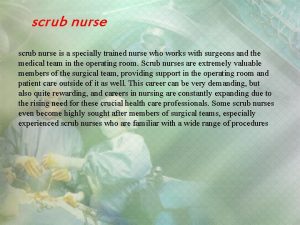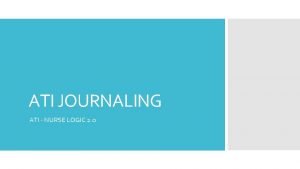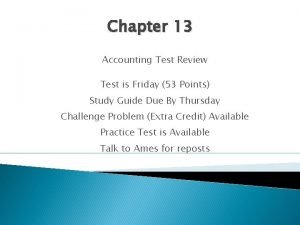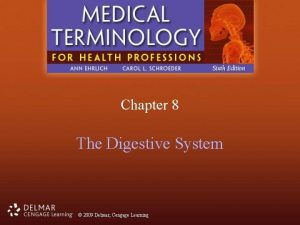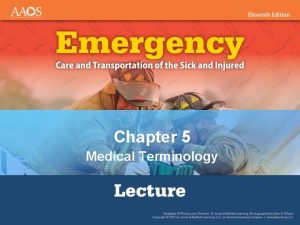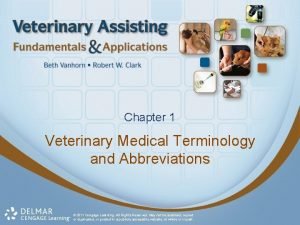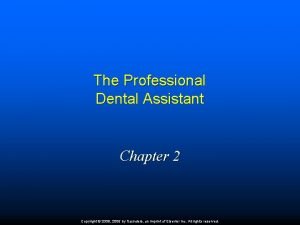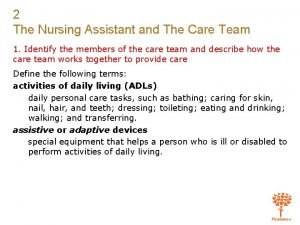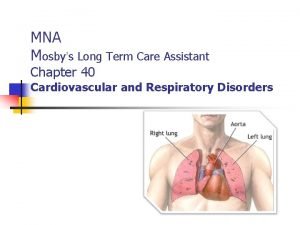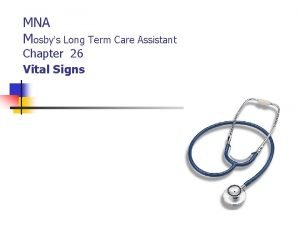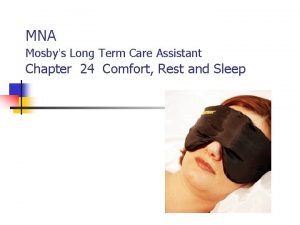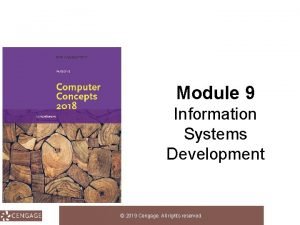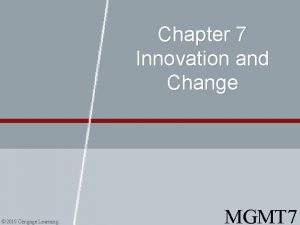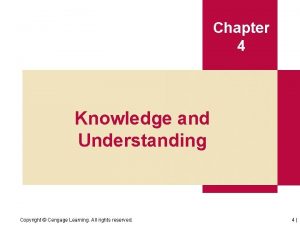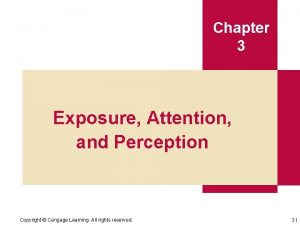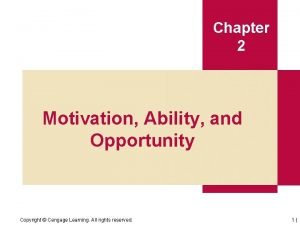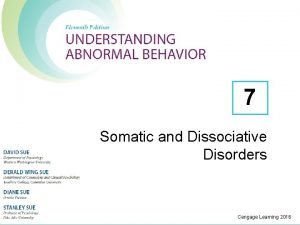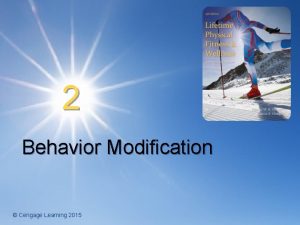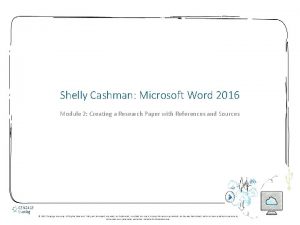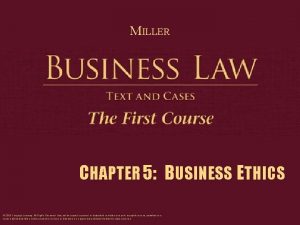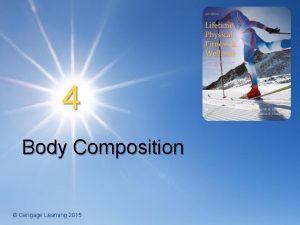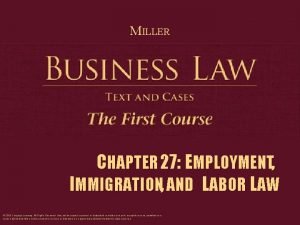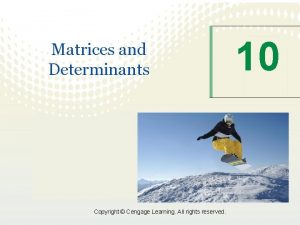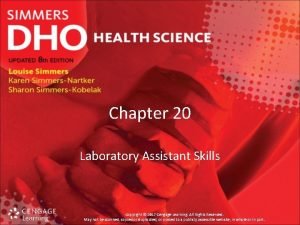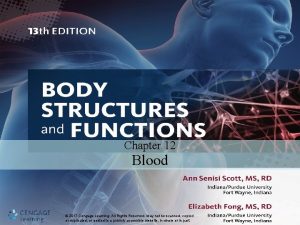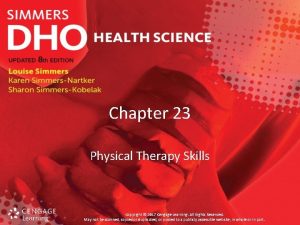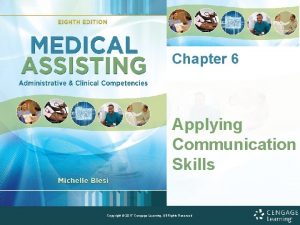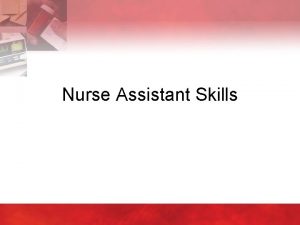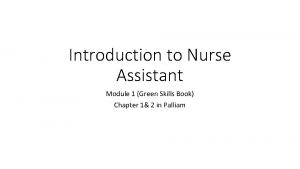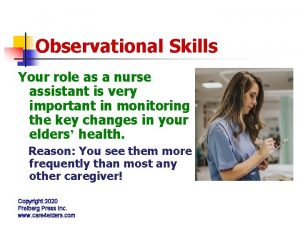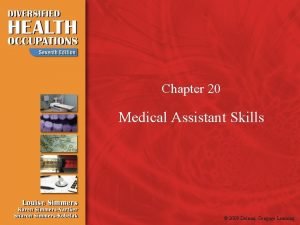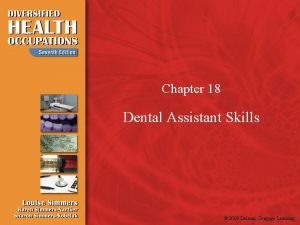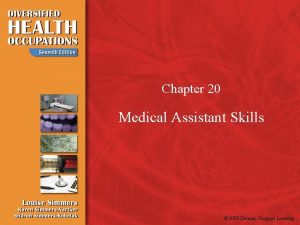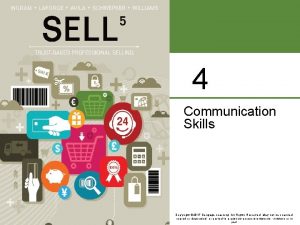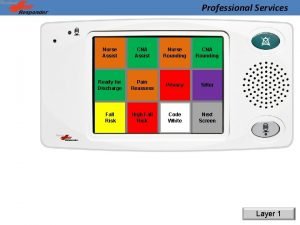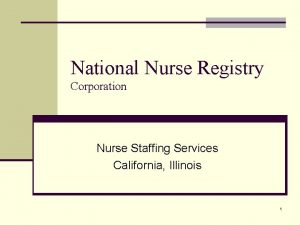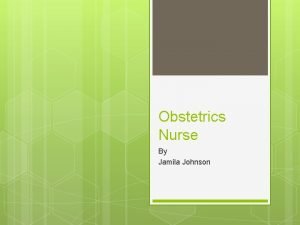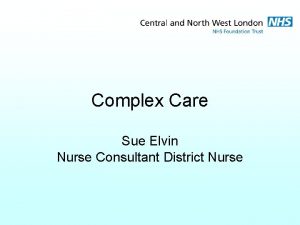Chapter 22 Nurse Assistant Skills Copyright 2017 Cengage




































































- Slides: 68

Chapter 22 Nurse Assistant Skills Copyright © 2017 Cengage Learning. All Rights Reserved. May not be scanned, copied or duplicated, or posted to a publicly accessible website, in whole or in part.

22: 1 Admitting, Transferring, and Discharging Patients • • • Procedures vary slightly in different facilities Basic principles apply to all facilities Alleviate a patient’s anxiety and fear Create a positive first impression Admission forms (refer to Figure 22 -1 in text) Copyright © 2017 Cengage Learning. All Rights Reserved. May not be scanned, copied or duplicated, or posted to a publicly accessible website, in whole or in part.

22: 1 Admitting, Transferring, and Discharging Patients • Procedures performed on admission – Protect patient’s or resident’s possessions – Orient patient and family members to facility • Transfers – May be related to patient’s condition – May be requested by patient Copyright © 2017 Cengage Learning. All Rights Reserved. May not be scanned, copied or duplicated, or posted to a publicly accessible website, in whole or in part.

22: 1 Admitting, Transferring, and Discharging Patients • Discharges – Physician’s order usually required – Leaving against medical advice (AMA) • Follow facility procedures for discharge or transfer • Refer to Procedures 22: 1 A– 1 C in text Copyright © 2017 Cengage Learning. All Rights Reserved. May not be scanned, copied or duplicated, or posted to a publicly accessible website, in whole or in part.

22: 2 Positioning, Turning, Moving, and Transferring Patients • If done correctly, the procedure provides patient with optimum comfort and care • When done correctly, helps worker prevent injury to self and patient • Improper moving, turning, or transferring can result in serious injury Copyright © 2017 Cengage Learning. All Rights Reserved. May not be scanned, copied or duplicated, or posted to a publicly accessible website, in whole or in part.

22: 2 Positioning, Turning, Moving, and Transferring Patients • If unsure, always ask a supervisor before attempting a procedure • Correct body mechanics are essential for any of these procedures • If you are unable to move or turn a patient by yourself, always get help Copyright © 2017 Cengage Learning. All Rights Reserved. May not be scanned, copied or duplicated, or posted to a publicly accessible website, in whole or in part.

Alignment • Positioning body parts in relation to each other to maintain correct body posture • Benefits – Prevent fatigue – Prevent pressure ulcers (also called decubitus ulcer, pressure sore, or bedsore) – Prevent contractures Copyright © 2017 Cengage Learning. All Rights Reserved. May not be scanned, copied or duplicated, or posted to a publicly accessible website, in whole or in part.

Turning • Patients confined to bed must be turned at least every 2 hours • Frequent turning – Provides exercise for muscles, stimulates circulation, decreases pulmonary congestion, prevents pressure ulcers and contractures, provides patient comfort Copyright © 2017 Cengage Learning. All Rights Reserved. May not be scanned, copied or duplicated, or posted to a publicly accessible website, in whole or in part.

Dangling • Sitting with legs hanging down over side of bed • Used before transfer of a patient • Pulse rate is checked before, during, and after • Orthostatic hypotension may occur Copyright © 2017 Cengage Learning. All Rights Reserved. May not be scanned, copied or duplicated, or posted to a publicly accessible website, in whole or in part.

Transfers • Patients are transferred in wheelchairs, or stretchers • Mechanical lift may be used for transfer of weak or paralyzed patient • Never transfer a patient without authorization • Watch patient carefully during move/transfer Copyright © 2017 Cengage Learning. All Rights Reserved. May not be scanned, copied or duplicated, or posted to a publicly accessible website, in whole or in part.

22: 3 Bedmaking • Correctly made bed provides comfort and protection for patients confined to bed for long periods • Care must be taken when beds are made • Beds must be free from wrinkles, which can cause discomfort and lead to pressure ulcers Copyright © 2017 Cengage Learning. All Rights Reserved. May not be scanned, copied or duplicated, or posted to a publicly accessible website, in whole or in part.

22: 3 Bedmaking • Mitered corners to hold linens in place – Refer to Figure 22 -22 in text • Types of made beds – Closed bed – Occupied bed —Open bed —Bed cradle Copyright © 2017 Cengage Learning. All Rights Reserved. May not be scanned, copied or duplicated, or posted to a publicly accessible website, in whole or in part.

22: 3 Bedmaking Draw sheets or underpads Observe correct body mechanics PPE and infection control Standard precautions for removal of contaminated linens • Refer to Procedures 22: 3 A– 23: 3 D in text • • Copyright © 2017 Cengage Learning. All Rights Reserved. May not be scanned, copied or duplicated, or posted to a publicly accessible website, in whole or in part.

22: 4 Administering Personal Hygiene • Usually includes bath, back care, perineal care, oral hygiene, hair care, nail care, shaving • Must be sensitive to patients’ needs and respect their right to privacy while personal care is administered • Reasons for providing personal hygiene Copyright © 2017 Cengage Learning. All Rights Reserved. May not be scanned, copied or duplicated, or posted to a publicly accessible website, in whole or in part.

Types of Baths • Types of baths – Complete bed bath (CBB) – Partial bed bath – Tub bath or shower – Waterless bath Copyright © 2017 Cengage Learning. All Rights Reserved. May not be scanned, copied or duplicated, or posted to a publicly accessible website, in whole or in part.

Oral Hygiene • Care of mouth and teeth – At least three times a day • Routine oral hygiene • Denture care • Special oral hygiene Copyright © 2017 Cengage Learning. All Rights Reserved. May not be scanned, copied or duplicated, or posted to a publicly accessible website, in whole or in part.

Hair Care • Often neglected aspect of care • Brushing stimulates circulation, helps prevent scalp disease • Report any observed signs of disease • Shampooing must be physician approved Copyright © 2017 Cengage Learning. All Rights Reserved. May not be scanned, copied or duplicated, or posted to a publicly accessible website, in whole or in part.

Nail Care • Often neglected in personal care of patient • Nails may not be cut without physician order – May require licensed or advanced personnel • Never cut toenails – Foot injuries are prone to infection and slow healing Copyright © 2017 Cengage Learning. All Rights Reserved. May not be scanned, copied or duplicated, or posted to a publicly accessible website, in whole or in part.

Shaving • Normal daily routine for most men • Use regular or electric razor • Follow correct technique to prevent patient injury • Physician order required before shaving any patient Copyright © 2017 Cengage Learning. All Rights Reserved. May not be scanned, copied or duplicated, or posted to a publicly accessible website, in whole or in part.

Back Rub • Given as part of daily bath unless contraindicated • Perform at least once every 8 hours for patients confined to bed • Takes 4– 7 minutes • Stimulates circulation, prevents pressure ulcers, relaxes and comforts patient Copyright © 2017 Cengage Learning. All Rights Reserved. May not be scanned, copied or duplicated, or posted to a publicly accessible website, in whole or in part.

Changing a Gown or Clothing • If a patient has weak/injured arm or is receiving an intravenous solution – Position clothing with care – Unclothe uninjured/untreated arm first • Patients in long-term care may wear regular clothing during day Copyright © 2017 Cengage Learning. All Rights Reserved. May not be scanned, copied or duplicated, or posted to a publicly accessible website, in whole or in part.

Summary • Report – Sores, cut, injuries – Rashes – Color – Swelling or edema – Signs of distress • Refer to Procedures 22: 4 A– 22: 4 J in text Copyright © 2017 Cengage Learning. All Rights Reserved. May not be scanned, copied or duplicated, or posted to a publicly accessible website, in whole or in part.

22: 5 Measuring and Recording Intake and Output • Need for balance of fluid taken into body and fluid lost from body • Fluid retention: swelling (edema) • Fluid loss: dehydration • Intake and output (I&O) records/forms vary between facilities Copyright © 2017 Cengage Learning. All Rights Reserved. May not be scanned, copied or duplicated, or posted to a publicly accessible website, in whole or in part.

Intake • All fluids taken in by patient – Oral – Tube feedings or enteral feedings – Intravenous (IV) fluids – Tubes and drains Copyright © 2017 Cengage Learning. All Rights Reserved. May not be scanned, copied or duplicated, or posted to a publicly accessible website, in whole or in part.

Output • All fluids eliminated by patient – Bowel movement (BM) – Emesis – Urine – Tubes and drains Copyright © 2017 Cengage Learning. All Rights Reserved. May not be scanned, copied or duplicated, or posted to a publicly accessible website, in whole or in part.

Recording Intake and Output (I&O) • Records must be accurate – Refer to Figure 22 -51 in text • • • Amounts measured in graduates Fluids are measured in milliliters (m. L) Agencies have different policies for recording I&O Follow standard precautions Refer to Procedure 22: 5 in text Copyright © 2017 Cengage Learning. All Rights Reserved. May not be scanned, copied or duplicated, or posted to a publicly accessible website, in whole or in part.

22: 6 Feeding a Patient • Good nutrition is an important part of patient’s treatment • Make mealtimes as pleasant as possible • Mealtimes are regarded as social time • Patient preparation before food tray arrives • Explain any delay of meals Copyright © 2017 Cengage Learning. All Rights Reserved. May not be scanned, copied or duplicated, or posted to a publicly accessible website, in whole or in part.

22: 6 Feeding a Patient • Check food tray against patient name, room number, and diet ordered • Check diet order before adding food to tray • Allow patient to feed themselves when possible • Test food temperature before feeding patient Copyright © 2017 Cengage Learning. All Rights Reserved. May not be scanned, copied or duplicated, or posted to a publicly accessible website, in whole or in part.

22: 6 Feeding a Patient • Principles to follow while feeding patient – Refer to Procedure 22: 6 in text • Observe amount eaten for intake record • Record intake if I&O is being kept • Be alert for any signs of choking Copyright © 2017 Cengage Learning. All Rights Reserved. May not be scanned, copied or duplicated, or posted to a publicly accessible website, in whole or in part.

22: 7 Assisting with a Bedpan/Urinal • Elimination of body waste is essential – Urinate, micturate, or void – Defecate • Many patients are sensitive about using bedpan/urinal • Refer to Procedures 22: 7 A– 22: 7 B Copyright © 2017 Cengage Learning. All Rights Reserved. May not be scanned, copied or duplicated, or posted to a publicly accessible website, in whole or in part.

22: 7 Assisting with a Bedpan/Urinal • Accurate observations of frequency, amount, and appearance of urine/stool are important • Measure and record for I&O • Observe standard precautions – Frequent handwashing – Use of gloves Copyright © 2017 Cengage Learning. All Rights Reserved. May not be scanned, copied or duplicated, or posted to a publicly accessible website, in whole or in part.

22: 8 Providing Catheter and Urinary. Drainage Unit Care • Catheter – Hollow tube usually made of rubber or plastic • Urethral or straight catheter • Foley (indwelling or retention) catheter • External condom catheter Copyright © 2017 Cengage Learning. All Rights Reserved. May not be scanned, copied or duplicated, or posted to a publicly accessible website, in whole or in part.

22: 8 Providing Catheter and Urinary. Drainage Unit Care • Urinary-drainage unit – Bag attached to catheter to collect drained urine – Leg bags for ambulatory patients • Carefully observe catheter and drainage unit Copyright © 2017 Cengage Learning. All Rights Reserved. May not be scanned, copied or duplicated, or posted to a publicly accessible website, in whole or in part.

22: 8 Providing Catheter and Urinary. Drainage Unit Care • Do not disconnect unit when catheter and urinary-drainage unit in place – If necessary to disconnect catheter, follow agency policy • Catheter care to prevent infection in bladder or kidneys Copyright © 2017 Cengage Learning. All Rights Reserved. May not be scanned, copied or duplicated, or posted to a publicly accessible website, in whole or in part.

22: 8 Providing Catheter and Urinary. Drainage Unit Care • Observation of urine – Amount, type, color, presence of other substances • Bladder training program after removal • Follow standard precautions • Refer to Procedures 22: 8 A– 22: 8 B in text Copyright © 2017 Cengage Learning. All Rights Reserved. May not be scanned, copied or duplicated, or posted to a publicly accessible website, in whole or in part.

22: 9 Providing Ostomy Care • Ostomy – Surgical procedure in which an opening, called a stoma, is created in abdominal wall • Ostomy allows waste to be expelled • Performed due to tumors, birth defects, ulcerative colitis, bowel obstruction, injury Copyright © 2017 Cengage Learning. All Rights Reserved. May not be scanned, copied or duplicated, or posted to a publicly accessible website, in whole or in part.

22: 9 Providing Ostomy Care • Types of ostomies – Ureterostomy – Ileostomy – Colostomy • Bag or pouch worn over stoma to collect drainage Copyright © 2017 Cengage Learning. All Rights Reserved. May not be scanned, copied or duplicated, or posted to a publicly accessible website, in whole or in part.

22: 9 Providing Ostomy Care • Stoma and skin care to prevent irritation – Qualifications for routine stoma care • • Psychological reactions to ostomy Observations while caring for ostomy Observe standard precautions Refer to Procedure 22: 9 in text Copyright © 2017 Cengage Learning. All Rights Reserved. May not be scanned, copied or duplicated, or posted to a publicly accessible website, in whole or in part.

22: 10 Collecting Stool/Urine Specimens • Laboratory tests are performed on specimens to detect disease • Specimens must be collected correctly for tests to be accurate Copyright © 2017 Cengage Learning. All Rights Reserved. May not be scanned, copied or duplicated, or posted to a publicly accessible website, in whole or in part.

Routine Urine Specimen • One of the most common specimens • Usually collected from first voided urine in morning (more concentrated) • Bedpan, urinal, specimen collector • 120 m. L of urine is sufficient • Send specimen to lab immediately Copyright © 2017 Cengage Learning. All Rights Reserved. May not be scanned, copied or duplicated, or posted to a publicly accessible website, in whole or in part.

Clean-Catch, or Midstream-Voided, Specimen • • • Specimen that is free from contamination Sterile urine-specimen container Cleanse genital area thoroughly Sterile container used to catch sample Place sterile lid on specimen immediately Copyright © 2017 Cengage Learning. All Rights Reserved. May not be scanned, copied or duplicated, or posted to a publicly accessible website, in whole or in part.

Catheterization for Sterile Urine Specimen • Use of catheter or specimen collection catheter for sterile urine specimen • Work under supervision and use sterile technique to prevent contamination of catheter Copyright © 2017 Cengage Learning. All Rights Reserved. May not be scanned, copied or duplicated, or posted to a publicly accessible website, in whole or in part.

24 -Hour Urine Specimen • Needed for Special tests – Check kidney function • Urine is preserved using chemicals and/or cold storage • Patient voids, and test begins on empty bladder Copyright © 2017 Cengage Learning. All Rights Reserved. May not be scanned, copied or duplicated, or posted to a publicly accessible website, in whole or in part.

Routine Stool Specimen • Stool (feces) specimen is examined in laboratory • Stool is placed in stool-specimen container • Examined within 30 minutes for most accurate results Copyright © 2017 Cengage Learning. All Rights Reserved. May not be scanned, copied or duplicated, or posted to a publicly accessible website, in whole or in part.

Stool for Occult Blood • • Occult blood can be found in feces Use of a special card and developing solution Positive result indicates blood in stool Send results to lab as soon as possible Copyright © 2017 Cengage Learning. All Rights Reserved. May not be scanned, copied or duplicated, or posted to a publicly accessible website, in whole or in part.

Summary • Label specimens correctly • Observe standard precautions • Take precautions to prevent spread of infection • Refer to Procedure 22: 10 A– 22: 10 E in text Copyright © 2017 Cengage Learning. All Rights Reserved. May not be scanned, copied or duplicated, or posted to a publicly accessible website, in whole or in part.

22: 11 Enemas and Rectal Treatments • Enema – Injection of fluid into large intestine and through rectum to remove feces and flatus • Physician’s order is required • Retention enemas • Nonretention enemas Copyright © 2017 Cengage Learning. All Rights Reserved. May not be scanned, copied or duplicated, or posted to a publicly accessible website, in whole or in part.

22: 11 Enemas and Rectal Treatments • Types of enemas – Cleansing – Disposable – Oil retention • Patient is placed in Sims’ (left lateral) position to receive enema Copyright © 2017 Cengage Learning. All Rights Reserved. May not be scanned, copied or duplicated, or posted to a publicly accessible website, in whole or in part.

22: 11 Enemas and Rectal Treatments • Impactions – May be removed by licensed or advanced care provider • Rectal tube used to expel flatus • Suppository – Inserted into rectum, melted by body heat Copyright © 2017 Cengage Learning. All Rights Reserved. May not be scanned, copied or duplicated, or posted to a publicly accessible website, in whole or in part.

22: 11 Enemas and Rectal Treatments • Enemas and rectal treatments cannot be administered without a doctor’s order • Follow correct procedures at all times • Observe standard precautions to prevent spread of infection • Refer to Procedures 22: 11 A– 22: 11 D in text Copyright © 2017 Cengage Learning. All Rights Reserved. May not be scanned, copied or duplicated, or posted to a publicly accessible website, in whole or in part.

22: 12 Applying Restraints • Used to limit movement – Chemical restraints: medications – Physical restraints: protective devices • Follow OBRA legislation for appropriate use • Circumstances that may require restraints • Refer to Procedures 22: 12 A– 22: 12 B in text Copyright © 2017 Cengage Learning. All Rights Reserved. May not be scanned, copied or duplicated, or posted to a publicly accessible website, in whole or in part.

22: 12 Applying Restraints • Types of physical restraints – Straps or safety belts – Limb restraints – Restraint jackets – Geriatric chair – Hand mitts Copyright © 2017 Cengage Learning. All Rights Reserved. May not be scanned, copied or duplicated, or posted to a publicly accessible website, in whole or in part.

22: 12 Applying Restraints • Points to remember when using restraints – Frequently check patients under restraint • Complications of restraints • Most health care facilities have specific rules and policies regarding the use of restraints • Be aware of legal responsibilities Copyright © 2017 Cengage Learning. All Rights Reserved. May not be scanned, copied or duplicated, or posted to a publicly accessible website, in whole or in part.

22: 13 Administering Preoperative and Postoperative Care • Three phases of operative care – Preoperative care (pre-op) – Operative care (peri-op) – Postoperative care (post-op) • Every patient will have some fears • Refer to Procedures 22: 13 A– 22: 13 D in text Copyright © 2017 Cengage Learning. All Rights Reserved. May not be scanned, copied or duplicated, or posted to a publicly accessible website, in whole or in part.

Preoperative Care • • Operative permit Laboratory tests Enemas/vaginal irrigations Baths Vital signs NPO Valuables Remove prosthetics • Remove cosmetics • Skin preparation or surgical shave • Clothing • Name band • Voiding • Surgical checklist Copyright © 2017 Cengage Learning. All Rights Reserved. May not be scanned, copied or duplicated, or posted to a publicly accessible website, in whole or in part.

Anesthesia • • Pain prevention by way of loss of sensation General anesthesia Local anesthesia Spinal anesthesia Copyright © 2017 Cengage Learning. All Rights Reserved. May not be scanned, copied or duplicated, or posted to a publicly accessible website, in whole or in part.

Postoperative Care • • Vital signs Dressings IV Level of pain Observations Position Cough and deep breath • • • Binders Surgical (elastic) hose Compression hose Montgomery straps Wound VACs Copyright © 2017 Cengage Learning. All Rights Reserved. May not be scanned, copied or duplicated, or posted to a publicly accessible website, in whole or in part.

22: 14 Applying Binders • Usually made of heavy cotton or flannelette with elastic sides or supports • Used to – Provide support and relief – Hold dressings in place – Limit motion – Apply pressure Copyright © 2017 Cengage Learning. All Rights Reserved. May not be scanned, copied or duplicated, or posted to a publicly accessible website, in whole or in part.

22: 14 Applying Binders • • Straight binders Breast binders T-binders Applying binders – Refer to Procedure 22: 14 in text Copyright © 2017 Cengage Learning. All Rights Reserved. May not be scanned, copied or duplicated, or posted to a publicly accessible website, in whole or in part.

22: 15 Administering Oxygen • Check legal responsibilities regarding oxygen administration • Blood must have oxygen • Signs of oxygen shortage • Deficiency of oxygen (hypoxia) • Physician’s order usually required Copyright © 2017 Cengage Learning. All Rights Reserved. May not be scanned, copied or duplicated, or posted to a publicly accessible website, in whole or in part.

Methods of Administering Oxygen • Mask • Cannula – Placed in nostrils • Tent – Patient is surrounded with high concentration of oxygen Copyright © 2017 Cengage Learning. All Rights Reserved. May not be scanned, copied or duplicated, or posted to a publicly accessible website, in whole or in part.

Oxygen Delivery Systems • Most hospitals pipe oxygen in through the wall • In United States, oxygen is color coded with green label • Portable oxygen cylinders or oxygen concentrators • May be stored as liquid Copyright © 2017 Cengage Learning. All Rights Reserved. May not be scanned, copied or duplicated, or posted to a publicly accessible website, in whole or in part.

Safety Precautions • Burning is more rapid/intense if O 2 present – Smoking/open flames are prohibited – Caution patient against smoking – Avoid use of electric equipment – Do not use flammable liquids – Use cotton bed linens – Inspect area frequently Copyright © 2017 Cengage Learning. All Rights Reserved. May not be scanned, copied or duplicated, or posted to a publicly accessible website, in whole or in part.

Pulse Oximeters • Monitor patient receiving oxygen • Measures level of O 2 in arterial blood – Photo-detector probe clipped to patient’s finger – Percentage of O 2 appears on monitor screen Copyright © 2017 Cengage Learning. All Rights Reserved. May not be scanned, copied or duplicated, or posted to a publicly accessible website, in whole or in part.

Summary • Patients receiving oxygen should be checked frequently • Note quality of respirations • Check safety precautions frequently • Refer to Procedure 22: 15 in text Copyright © 2017 Cengage Learning. All Rights Reserved. May not be scanned, copied or duplicated, or posted to a publicly accessible website, in whole or in part.

22: 16 Giving Postmortem Care • Care given to the body immediately following death • Begins when a doctor has pronounced a patient dead • Difficult but essential part of patient care • Control emotions and support family Copyright © 2017 Cengage Learning. All Rights Reserved. May not be scanned, copied or duplicated, or posted to a publicly accessible website, in whole or in part.

22: 16 Giving Postmortem Care • Patients’ rights still apply after death • Family members may want to view body • Procedure for postmortem care will vary by facility • Use of morgue kits Copyright © 2017 Cengage Learning. All Rights Reserved. May not be scanned, copied or duplicated, or posted to a publicly accessible website, in whole or in part.

22: 16 Giving Postmortem Care • Care of patients’ valuables and belongings • Two people often work together to complete care • Observe agency policy regarding procedures • Refer to Procedure 22: 16 in text Copyright © 2017 Cengage Learning. All Rights Reserved. May not be scanned, copied or duplicated, or posted to a publicly accessible website, in whole or in part.
 Copyright cengage learning. powered by cognero
Copyright cengage learning. powered by cognero Responsibilities of scrub nurse
Responsibilities of scrub nurse A nurse preceptor is orienting a newly licensed nurse
A nurse preceptor is orienting a newly licensed nurse Copyright secondary sara (2017) answers
Copyright secondary sara (2017) answers Chapter 7 cengage
Chapter 7 cengage Cengage chapter 7
Cengage chapter 7 2009 delmar cengage learning
2009 delmar cengage learning Chapter 13 accounting study guide
Chapter 13 accounting study guide Cengage chapter 5
Cengage chapter 5 Cengage chapter 8 answers
Cengage chapter 8 answers Knowledge of medical terminology
Knowledge of medical terminology Matching muscle directions and positions
Matching muscle directions and positions Prescription terms
Prescription terms The assistant chapter 2
The assistant chapter 2 The nursing assistant and the care team
The nursing assistant and the care team Cardiovascular disorders
Cardiovascular disorders Thermometer 97 degrees
Thermometer 97 degrees The assistant chapter 24
The assistant chapter 24 Describe the care team and the chain of command
Describe the care team and the chain of command Intra-personal skills
Intra-personal skills Hard skills vs soft skills
Hard skills vs soft skills Ontario skills passport essential skills
Ontario skills passport essential skills Cengage differential equations
Cengage differential equations Bank reconciliation cengage
Bank reconciliation cengage Separation of variables differential equations
Separation of variables differential equations Chapter 6:2 interpreting word parts
Chapter 6:2 interpreting word parts Cengage learning heart diagram
Cengage learning heart diagram Cengage
Cengage Cengage
Cengage Cengage
Cengage South-western cengage learning
South-western cengage learning Cengage
Cengage Cengage
Cengage Cengage
Cengage 2009 delmar cengage learning
2009 delmar cengage learning Cengage learning heart diagram
Cengage learning heart diagram Medical terminology chapter 1 learning exercises answers
Medical terminology chapter 1 learning exercises answers Cengage learning australia
Cengage learning australia Graphing tpr
Graphing tpr Cengage learning
Cengage learning Cengage learning
Cengage learning Module 1 computer concepts skills training
Module 1 computer concepts skills training Halpert's dimensions of charisma
Halpert's dimensions of charisma Wadsworth cengage learning
Wadsworth cengage learning Cengage
Cengage Cengage learning
Cengage learning Cengage
Cengage Cengage learning plant cell
Cengage learning plant cell Cengage
Cengage Cengage learning
Cengage learning Motivation, ability, and opportunity consumer behaviour
Motivation, ability, and opportunity consumer behaviour Cengage learning
Cengage learning Cengage
Cengage Cengage
Cengage Brooks cole cengage learning
Brooks cole cengage learning Cengage interview process
Cengage interview process Cengage
Cengage Cengage
Cengage Word module 2 creating a research paper
Word module 2 creating a research paper Geometric sequence function
Geometric sequence function Cengage intro to business
Cengage intro to business 2014 cengage learning accounting answers
2014 cengage learning accounting answers Cengage
Cengage All rights reserved formula
All rights reserved formula Cengage layoffs
Cengage layoffs Consistency of equations using determinants
Consistency of equations using determinants Cengage.com
Cengage.com Cengage learning
Cengage learning Cu webassign
Cu webassign

